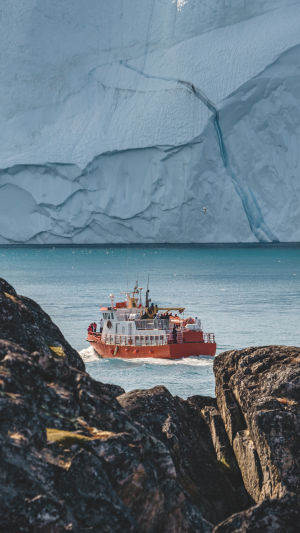Ilulissat Ice Bay is located on the west coast of Greenland.
Ilulissat is one of the northernmost human settlements in the world and the most uninhabitable.
This is because most areas here have year-round air temperatures below 0°C, with some places as cold as -70°C.
The fastest and most active glacier in the world can be seen in Ilulissat Icefjord.
The huge icebergs move at a speed of tens of meters per day, and the colorful wooden houses on the shore gradually shrink in the sight of a traditional wooden boat going out at night, eventually becoming like children's toy building blocks.
In Greenland, the best time of year to go whale watching is from May to August.
We can take a whale watching cruise and it will be an unforgettable trip to step into the whale kingdom.
As many as 15 species of whales swim in Greenland, with humpback, orca, and baleen whales being the most common.
There is up to a 90% chance of seeing whales in Greenland.
1. Humpback whale
The humpback whale is one of the largest whales to be seen in Greenland.
Taking its name from its humpback-like dorsal fin, the humpback is very plump, heart-shaped and about 3 meters tall.
It has a huge caudal fin that grows like a long glove and a tail that can reach 5-6 meters wide.
Dotted with black and white stripes on the underside, adult humpbacks are about 15-17 meters long.
Their weight is only 35 tons.
As a result, they are extremely light and they are considered the ocean acrobats of large whales.
They like to get close to ships and are curious about them.
Usually, humpback whales like to jump out of the water.
Before diving, it will wiggle its white tail at the bottom and make a huge splash when it lands.
Seeing humpback whales jumping out of the water, wagging their tails and diving is a truly unique experience, so you have the opportunity to take some incredible photos.
2. Fin Whale
The fin whale is the second longest animal in the world after the blue whale, with a body length of 17 to 24 meters and a weight of 80-90 tons. The female fin whale is larger than the male fin whale.
Despite their weight, fin whales are long and slender, with a dark gray upper body and a white belly with a white tail.
Fin whales usually dive to depths of 100-200 meters to feed on krill and small crustaceans.
When they feed, they open their mouths so that they hold more water in their mouths than the weight of the whale itself.
It has a lung capacity of 15,000 liters and dives for up to 20 minutes at a time.
When you're standing on deck and suddenly see a jet of water spewing out of the sea, like an Icelandic geyser, congratulations!
This indicates that the whale is close to your side.
In recent years, with frequent whaling activities, the global whale population has declined dramatically.
Meeting the whales may be the biggest surprise of the trip.





